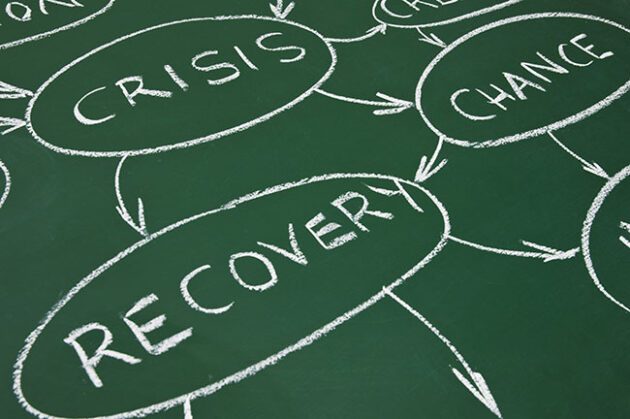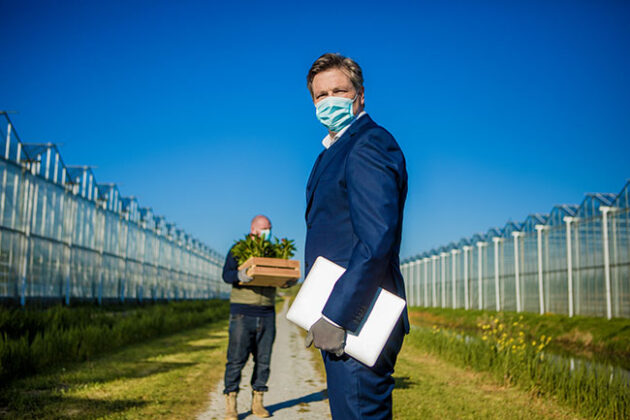
Features
Cultivating resilience
Crisis management planning for greenhouse operations is essential in preparing for and mitigating the inevitable
January 15, 2024 By J LYNN FRASER
 Karen White, Vice-President, Crisis Issues and Management, at NATIONAL Public Relations, says crisis management “involves three phases: planning; response; recovery.”
Source: NATIONAL Public Relations
Karen White, Vice-President, Crisis Issues and Management, at NATIONAL Public Relations, says crisis management “involves three phases: planning; response; recovery.”
Source: NATIONAL Public Relations The next pandemic may not be a coronavirus. Businesses cannot rely on strategies created to meet the demands of COVID-19 and its variants to cope with a new pandemic. According to Salazare et al. (2022), influenza and antibiotic resistance are among the “dangerous pathogens” that may cause another pandemic. The World Health Organization (WHO) predicts that new pandemics will occur more often, will “spread more rapidly,” and will cause more deaths (2022). The 2021 Global Health Security Index (GHSI, 2021) evaluated the ability of 195 countries to “prepare for epidemics and pandemics.” Canada placed fourth. Overall, the GHSI found that “all countries remain ‘dangerously unprepared’ for the next major outbreak.” This troubling statement is made more disturbing by a recent study published in the US’s well-respected Proceedings of the National Academy of Sciences journal, which concluded “we estimate that the yearly probability of occurrence of extreme epidemics can increase up to threefold in the coming decades” (PNAS, 2021), in fact some estimates place the likelihood of another pandemic similar to COVID-19 at 27 per cent in the next 10 years (Pringle, 2023).
Planning for and preventing the inevitable
Companies should have a crisis management plan (CMP) in place to ensure that in a crisis they act quickly to minimize negative consequences and to facilitate a quick return to business (NSF, 2023). A company’s successful response to a crisis depends on many factors such as “preparedness, maturity, size, scale of operations, and financial viability” (NSF, 2023).
“It was not necessarily greenhouses that were affected, but bunk houses as well as transportation to and from greenhouses,” said Jay Remsik, a Health and Safety Consultant with Workplace Safety and Prevention Services (WSPS) with 24 years of experience in the agricultural sector working with farms and greenhouses in the Windsor-Essex and Chatham-Kent areas of Ontario.
Government preparedness was important support for farmers. Following the “directives of Public Health Units (PHU), owners had to adapt the number of employees they were housing in bunk houses.”
Remsik notes that these directives sometimes lacked consistency. “I felt frustration as there was no consistency across the health units,” he commented.
A PHU in South Western Ontario told a grower with thirty workers that they could only have three people in the bunk house. During the pandemic, growers had to rent RVs, trailers, and hotel rooms for the workers.
Transportation to and from the bunk house to the greenhouse was also affected by social distancing as fewer workers were transported in more trips. “Larger greenhouses would use school buses. During the pandemic a large grower had to transport fewer workers and sanitize in between trips. Most of the operators adapted on the fly.”
Distancing directives were also applied within greenhouses. “Pickers in greenhouses, like for cucumbers, tomatoes, and peppers, were given four rows each,” Remsik said. “In pack lines there were challenges. Workers were separated by plexiglass sheets and wore PPE.
“Cross-training became very important,” says Remsik. A small business might have two forklifts. A larger business may have ten. If someone was ill another person, trained in anticipation of illness affecting the company, would be an alternate operator. Then the business could operate as normal.
Various levels of government health departments prepared and thus were available to give guidance. PHUs in South Western Ontario had “templates for screening procedures.” WSPS, for example, “partnered with the Ontario, Ministry of Agriculture, Food and Rural Affairs (OMAFRA) to deliver the service for those farmers accessing the $2,000 [in aid]” designated for each farmer’s assistance. “I did tail-gate talks with staff. Talks to increase awareness and reminders about the risks of COVID,” Remsik said. In addition, “WSPS met with growers virtually and helped them customize procedures to fit their businesses.”

PHOTO: Hiob/getty images
CMPs organize people
There are general steps in a crisis management plan that fit most companies, and which can be customized to meet specific company needs.
Step 1: Form a crisis management team.
Step 2: Determine management’s responsibilities.
Step 3: Critically examine the company’s weaknesses to determine threats “unique to your organization, location or region, market, products and processes” (NSF, 2023). Establish what are the warning signs that indicate stresses for the company.
Step 4: Create specific internal communication strategies.
Step 5: Create specific external communication strategies.
Step 6: For each type of crisis there should be an action plan.
Step 7: Establish a recovery plan.
Step 8: Monitor for threat(s).
Step 9: Know when to enact CMP.
Step 10: Know when to enact recovery plan. CMPs are successful when every employee, at every level, is responsible for implementing the CMP.
CMPs organize things
It is not just people who are affected by epidemics and pandemics. Supply chains, usually invisible and taken for granted, are also affected. During the pandemic global and local supply chains were often the lead in the news. The WHO warns that supply chains need to become “more agile in the face of immediate and unpredictable changes.” Strategies to achieve this goal in a company CMP should include “digitalization” to reduce reliance on global supply chains, and developing “supplier networks in multiple areas.”
Before the crisis a CMP should ensure that a qualified industrial hygienist or HVAC engineer assess a company’s greenhouses and other buildings. The American Conference of Governmental Industrial Hygienists and American Society of Heating, Refrigerating and Air Conditioning Engineers (ACGIH & ASHRAE, 2021) suggests that system designers should strive to “accommodate Tier 1 MERV filters (MERV 13 and 14) in their current and future designs.” It advises that maintenance of HVAC should be regular and thorough.
There are numerous “emerging technologies” for cleaning air (ACGIH & ASHRAE, 2021) including “ionization, plasma” and hydrogen peroxide as well as Ultraviolet Germicidal Irradiation that kills pathogens that are airborne (CDC, 2021a).
During the crisis, in companies that operate greenhouses it is not just the greenhouses that are affected. Buildings that house equipment, offices, break rooms, and staff work areas are exposed through direct contact. The ACGIH and ASHRAE (2021) recommends increasing the “outdoor air supply to 100%” or increase it to the “maximum allowed by the capabilities of the ventilation system.” Additionally, it suggests that there should be six to twelve air changes per hour. It also advises ensuring that the air brought into a ventilation system not intake air near a parking lot, a site of vehicle traffic, or near smoking areas. It cautions against allowing personal fans to be used. Exfiltration should be encouraged through “roof fans, soffit vents, windows, doors, and other openings.” Sanitization should be done regularly by all employees on a scheduled and per interaction basis depending on the characteristics of the pathogen involved.
After the crisis, according to the Center for Disease Control and Prevention, when the buildings that have been shut down for a long period of time (days to months), are reopened they should be checked for hazards such as Legionella (Legionnaires Disease), mould, sewer gases, lead and copper contamination (CDC, 2021b). ACGIH and ASHRAE (2021) suggest that if air intake is shut down for a period of time it should be put back to “full operating conditions” for a period of time prior to employees’ return.

‘Agile’ leadership and effective communication is key to navigating future crises.
Step 11: Dealing with a reputation crisis
When the reputation of a business is threatened due to slowdowns, lockdowns, and infections, there is resulting peril to stakeholders’ confidence in the company’s products and stability. At that critical time it is necessary to seek help.
A crisis involves an initial incident when the story becomes public and “questions and confusion” ensue. A company should then acknowledge the incident and state they are working on a plan. The company should then ask for understanding as they investigate the issue.
Next, blame will be assigned by the public and media. At this point, according to Karen White, Vice-President, Crisis Issues and Management, at NATIONAL Public Relations, “Canada’s leading PR firm,” those who have been seriously affected by the company’s actions or inactions should receive a personal visit or a phone call.
A statement about a commitment to learning from the incident should be made. As negative feedback from the public decreases the company should “demonstrate a commitment to action or change.”
“Crisis management involves three phases: planning; response; recovery,” says White who has provided “communications counsel and advice” for key actors in numerous well-known crisis events such as during the Fort McMurray wildfire “response.”
It is important to do a “communications audit” to establish a vulnerability risk assessment for areas of concern. White comments that the results are used to develop a plan that has: protocols, a chain of command, roles, a determination of stakeholders, audiences, resources, and tools.
In the communications stage “key line departments and functional areas” are involved. Planning must involve diverse perspectives.
The next step is to “customize and scale-up responses due to the seriousness of the issue.”
At this stage counsel is sought, a communications plan is made, draft materials created, and traditional as well as social media are monitored. In the recovery stage the lessons learned are reviewed; there is evaluation and reflection; and the process of rebuilding a reputation begins.
In the near future White foresees that in 2024 cyber threats, a different but important type of pandemic, will become a critical concern for companies.
“Cyber preparedness” should involve IT, legal, and communications, she advises. In internal communications employees, executives, and the company board should be informed about the plan. To a different degree stakeholders, suppliers, and the supply chain should also be informed.
The Toronto Public Library (TLP), at the time of writing this article, was affected by a cyberattack since October 28, 2023. It announced on November 23rd that the issue is not expected to be resolved until January 2024. The library serves 1.5-million patrons yearly who are currently unable to use the TLP’s full services.
Discussions about successful CMPs and businesses’ recovery after the pandemic refer to these main drivers of a successful recovery: responding quickly at each stage of the CMP; staff multi-tasking; keeping communications open at each stage of the crisis; and “open”, “agile” leadership (Permatusari & Mayuti, 2022).
“The coronavirus brought labour challenges to growers, but the industry saw a few silver linings in the adjustments it made during the pandemic. Greater efforts at communication paid off for some,” (Karst, 2021).
“Leadership is consequential,” was the conclusion of the UNDP (2022) and that “Effective leadership has been so important that it has been called the “ultimate vaccine” against coronavirus.”
Effective and adaptable CMPs along with strong communications and leadership will help the greenhouse industry manage the next pandemic(s).
Sources
ASHRAE & ASHRAE (2021). Position document on infectious aerosols. ACGIH® and ASHRAE® White Paper Ventilation for Industrial Settings during the COVID-19 Pandemic American Conference of Governmental Industrial Hygienists (ACGIH®), Industrial Ventilation Committee American Society of Heating, Refrigerating and Air-Conditioning Engineers (ASHRAE®), Technical Committee 9.2, Industrial Air Conditioning and Ventilation. Revised June 2021. https://www.ashrae.org/file%20library/technical%20resources/covid-19/ashrae-acgih-covid-19-white-paper.pdf
- CDC & Prevention (2021a). Upper-room Ultraviolet Germicidal Irradiation (UVGI). https://www.cdc.gov/coronavirus/2019-ncov/community/ventilation/uvgi.html
- CDC & Prevention (2021b). Reopening buildings after prolonged shutdown or reduced operation. https://www.cdc.gov/nceh/ehs/water/legionella/building-water-system.html
- Global Health Security Index. (2021). https://www.ghsindex.org/
- Intensity and frequency of extreme novel epidemics
- T. Karst (2021). COVID-19 adds stress but optimism still reigns for Ontario greenhouse producers. The Packer. https://www.thepacker.com/news/produce-crops/covid-19-adds-stress-optimism-still-reigns-ontario-greenhouse-producers
- M. Marani et al. (2021). 118(35) e2105482118. Proceedings of the National Academy of Sciences (PNAS). https://doi.org/10.1073/pnas.2105482118
- NSF (2023). Creating a successful management plan. https://www.nsf.org/knowledge-library/creating-successful-crisis-management-plan
- M.G. Permatusari & L.P. Mayuti (2022). Crisis management practices during the COVID-19 pandemic. Journal of General Management. 47(3): 180–190. doi: 10.1177/03063070211063717
- E. Pringle (2023). Disease forecasters are convinced there’s a 27% chance of another COVID-like pandemic within 10 years—but experts believe there’s a silver bullet. Fortune Well. https://fortune.com/well/2023/04/18/disease-forecasters-predict-new-covid-like-pandemic-within-10-years/
- C.B. Salazar et al. (2022). Future pandemics might be caused by bacteria and not viruses: Recent advances in medical preventive practice. May–Jun, 16(3): 1–3. https://www.ncbi.nlm.nih.gov/pmc/articles/PMC9092534/
- United Nations Development Programme (2022). Preparing for the next pandemic. What we have learned entering year three of COVID-19. https://stories.undp.org/preparing-for-the-next-pandemic?gad_source=1&gclid=EAIaIQobChMIuqi67qrRggMV1B-tBh0yjwxdEAAYAyAAEgJZSPD_BwE
- World Health Organization (2022). Imaging the future of pandemics and epidemics: A 2022 perspective. https://www.who.int/publications/i/item/9789240052093
Print this page